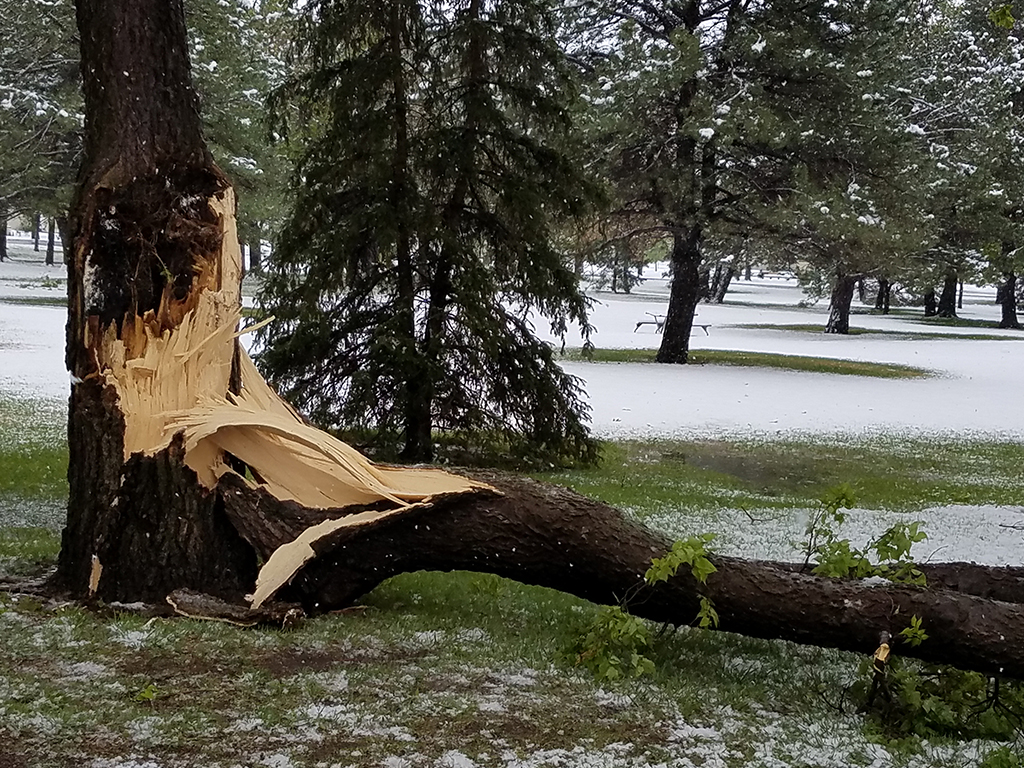
A damaged tree in Finnup Park, Garden City, Kansas. The tree was split by the weight of heavy snow from an unseasonably late snowfall. Photo by Kathy Sexson. | Download this photo.
When severe weather strikes, be mindful of tree damage
Foresters urge caution, patience
Friday, May 19, 2017
MANHATTAN, Kan. — Trees damaged during severe weather events often can recover if given proper care and attention.
The recent snowstorm in western Kansas damaged hundreds of trees in home landscapes and rural windbreaks. Broken branches, hanging limbs and even split trunks were common sights in communities such as Garden City.
“Trees can sustain damage in all kinds of severe weather, from the snow and ice of winter to the high winds and tornadoes of spring,” said John Klempa, a district forester with the Kansas Forest Service office in Garden City. “During the unusually heavy blizzard in western Kansas, we saw everything from the loss of small branches to entire trees falling over from the weight of snow sticking to the new leaves they had already produced.”
Klempa’s advice: When assessing damaged trees, start at the top — scan the upper branches for broken limbs, especially those that might be hanging by a few strands. Binoculars can be helpful if you have them. If the broken branches and limbs are big, leave them for a certified arborist.
Debris that’s close to active power lines should be reported to the local utility company so it can send trained technicians out to deal with them.
“A certified arborist is your best bet for addressing damaged trees after a severe event of some sort,” said Tim McDonnell, a community forest coordinator with the Kansas Forest Service office in Haysville. “Arborists have extensive education about tree care, and they’re trained to safely climb up into trees, if need be, to trim and prune trees to be stronger and healthier.”
Following a storm, it’s common to find individuals going door-to-door, soliciting business to take care of damaged trees. McDonnell said arborists and reputable tree-care companies are too busy to do this.
McDonnell added that arborists don’t just work after storms — they can also provide preventive maintenance that could help your trees withstand stresses from future storms.
If hiring a certified arborist isn’t an option for you, it’s possible to clean up tree damage yourself if you follow a few guidelines.
- Start with the structure — Cracks in the trunk, cracks in large branches, disturbed soil at the base of the trunk: All of these are signs of structural damage from which the tree may not be able to recover.
- Care for the canopy — The canopy of a tree is where the vast majority of the leaves are located. A tree that has lost more than half of its canopy may not have the nutrients and resources to replace so many leaves, and may not be able to recover.
- Saw safety — Never raise a conventional chainsaw above your chest. Powered pole saws are designed to reach up to higher branches. “When raising either, one should do a 360 [-degree review of the area] to make sure there are no utility issues,” McConnell said. Wear hand and eye protection, and always read and follow the manufacturer’s directions for any tool you use.
K-State Research and Extension has a publication on tree-trimming safety.
“Always watch around you,” continued McConnell. “The ‘struck-by’ is still the No. 1 accident and/or death in tree trimming work — being struck by a falling limb or branch.”
Lastly, know when to give up. “A tree that was struggling before a storm won’t suddenly recover after a storm,” McConnell added. “Removing an old, damaged tree offers an opportunity to start over with something different, perhaps a species better suited to the local climate.”
“Local extension agents and foresters are always ready to help you choose a new tree.”

